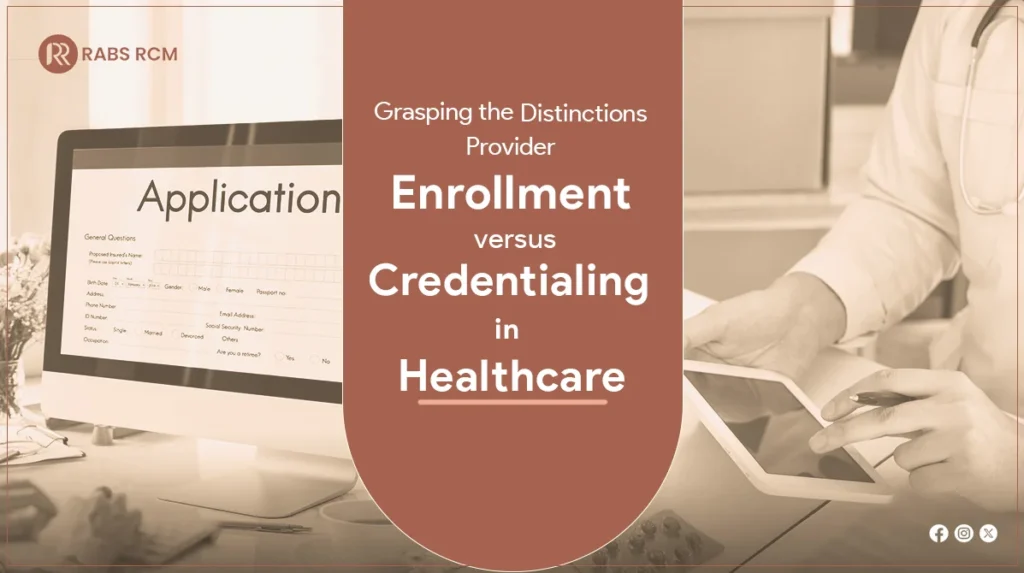
Grasping the Distinctions: Provider Enrollment versus Credentialing in Healthcare
In the complex world of healthcare administration, terms like “provider enrollment” and “credentialing” are often used interchangeably, leading to confusion among practitioners and administrators alike. However, these terms represent distinct processes, each serving a vital role in ensuring the delivery of quality care and adherence to regulatory standards. Let’s delve deeper into the nuances between provider enrollment and credentialing to gain a comprehensive understanding of their significance in the healthcare industry.
Provider Enrollment
Provider enrollment refers to the process through which healthcare providers, such as physicians, nurses, therapists, and other allied health professionals, establish relationships with insurance companies, government payers, and healthcare networks to participate in their respective networks and receive reimbursement for services rendered. It involves completing and submitting applications, along with supporting documentation, to become affiliated with payer organizations. The provider enrollment process typically includes:
Application Submission
Providers submit applications to insurance companies, Medicare, Medicaid, or other payer organizations, providing detailed information about their qualifications, credentials, practice locations, and services offered.
Verification of Credentials
Payer organizations verify the credentials and qualifications of providers to ensure they meet the required standards for participation in their networks. This may include verifying licenses, certifications, education, training, and professional experience.
Contract Negotiation
Once the provider’s credentials are verified, payer organizations may enter into contractual agreements with them, outlining reimbursement rates, terms of participation, and other contractual obligations.
Enrollment Approval
Upon successful completion of the enrollment process and contract negotiation, providers receive approval from payer organizations to participate in their networks and bill for services provided to covered patients.
Provider enrollment is crucial for healthcare providers to gain access to a broad patient population, expand their practice networks, and receive timely reimbursement for services rendered.
Credentialing
Credentialing, on the other hand, is a separate process that focuses on verifying and evaluating the qualifications, competence, and professional conduct of healthcare providers to ensure they meet specific standards and requirements set forth by accrediting bodies, regulatory agencies, and healthcare organizations. Credentialing is typically conducted by hospitals, healthcare facilities, and managed care organizations before granting privileges to providers to deliver patient care within their facilities. The credentialing process typically involves:
Application Submission
Providers submit credentialing applications, along with supporting documentation, to the credentialing committee or department of the healthcare organization.
Primary Source Verification
The credentialing committee verifies the authenticity of the provider’s credentials by directly contacting primary sources, such as educational institutions, licensing boards, and previous employers, to confirm qualifications, licenses, certifications, and professional references.
Peer Review
Credentialing committees may conduct peer reviews to assess the provider’s clinical competence, ethical conduct, and adherence to professional standards. Peer reviews involve evaluating clinical outcomes, patient satisfaction scores, and peer recommendations.
Decision Making
Based on the findings of the credentialing process, the credentialing committee makes decisions regarding granting or denying privileges to the provider. Privileges may include admitting privileges, surgical privileges, prescribing privileges, and other clinical privileges within the healthcare organization.
Credentialing is essential for ensuring patient safety, maintaining the quality of care, and mitigating risks associated with incompetent or unqualified providers practicing within healthcare settings.
Key Differences
While provider enrollment and credentialing share the common goal of facilitating provider participation in healthcare networks and ensuring quality of care, they differ in their focus and scope:
- Focus: Provider enrollment primarily focuses on establishing contractual relationships between providers and payer organizations to facilitate reimbursement for services, while credentialing focuses on evaluating and verifying the qualifications and competence of providers to ensure patient safety and quality of care.
- Authority: Provider enrollment is typically managed by payer organizations or insurance companies, while credentialing is conducted by healthcare facilities, hospitals, and managed care organizations.
- Scope: Provider enrollment involves verifying provider information related to insurance participation and reimbursement, while credentialing entails a comprehensive evaluation of a provider’s qualifications, clinical competence, and professional conduct.
Conclusion
Provider enrollment and credentialing are integral components of the healthcare system, each serving distinct purposes in facilitating provider participation and ensuring patient safety and quality of care. Understanding the differences between these processes is essential for healthcare providers, administrators, and policymakers to navigate the complex landscape of healthcare delivery and reimbursement effectively.

